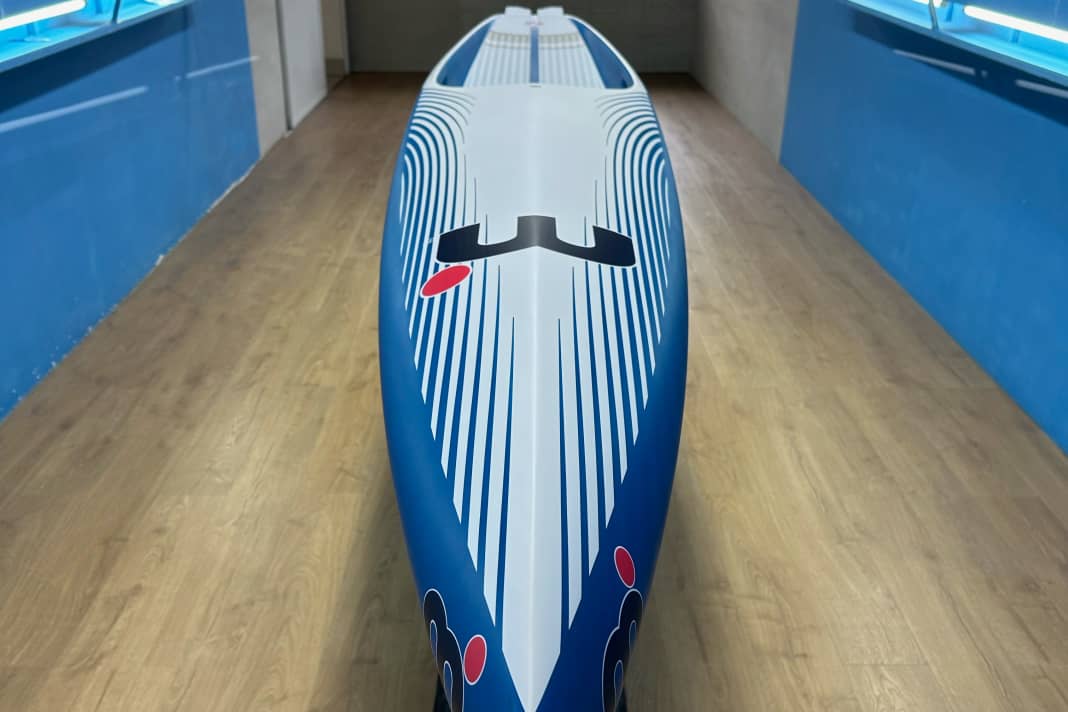





Mistral has had the Vortex race SUP in its programme since 2014. Back then, shortly after the brand was taken over by a Dutch investor, the board was intended to establish Mistral in the scene on the traditional "Eleven Cities Tour" in Frisian canals. Now the raceboard has been redesigned. To mark the occasion, Mistral explains in detail the philosophy behind the shape.
"Steve West was commissioned in September 2014 to develop and design a SUP board that would win races. The main problem seemed to be that former windsurfing designers were designing many SUP boards, forgetting that flat water boards are not planing boards, but are travelling in displacement more than 95% of the time because they are propelled only by human power and leverage. The trick was to develop a displacement hull in such a way that the drag coefficient is low and yet the board is not so unstable that it cannot be ridden comfortably. This means rounded hulls combined with flatter, stable sections to create a balance between speed and stability without making the board unrideable.
West drew on the design of paddleboards and outrigger canoes, which require low effort to operate yet need to be stable enough to be relatively easy to manoeuvre. Whilst the original Vortex board had a flat profile to reduce wind resistance, it was more of a 'wet board' than the current design, which nevertheless retains many of its original design elements. However, the nose and stance depth in particular have been adjusted over time based on rider feedback."
Design principles of the Mistral Vortex
By dividing the board into four sections, the nose was designed so that the water flows backwards and not forwards, explains Mistral. "I knew we had to eliminate the bow wave, which the board has to push over in order to gain top-end speed," explains West. A slightly inverted nose angle limits the bow wave so that the nose has minimal drag. Under water, the bow can be pulled along by the pressure wave it generates. "For the design of the 2025, we have found the best possible compromise for travelling through the waves and not always over them, which leads to a loss of speed and stability."
"From the nose to the standing area, the underwater hull reduces drag by having a certain roundness to maximise efficiency at displacement speeds, you can feel this advantage when you increase the stroke rate or power input and the board rises noticeably faster. The rail shape in this first section needs to be rounded so that the nose does not point or deflect in choppy water. These soft rails also provide additional lift where you need it."
The tail of the board is slightly concave
Close to the stance area, the underwater shape changes from round to flat to slightly concave, the Mistral people describe the shape of the Vortex. "Under the paddler's feet, we have to keep the hull relatively flat for the rider's stability, but we also have to consider the width of the board. The rails start to get sharper further back to aid directional stability and water drainage.
After the paddler's standing area, the concave continues and the rails become even sharper. The focus is on helping the water drain and minimising eddies at the tail that can hinder the board's progress. All these factors sound simple, but the key to optimising the design lies in perfecting the transition points between rounded, flat and concave in combination with the shape of the rails.
As far as the footprint is concerned, it is important to consider the effects of the wind and to realise that a high-sided board is severely affected by crosswinds and lateral runout. For this reason, we didn't set the sidewalls too high, but wanted to find a balance between stability, susceptibility to wind and a harmonious hull shape."
Vortex SD1 in two variants
A feature of the 2025 Vortex SD1, according to the manufacturer, is a reduction in tail volume for improved step-back turns and a lower rail height, plus a new drainage system for the deck with four pairs of exit points and a specially moulded system.
Alexander Mettes, Head of Research and Development at Mistral, comments: "We want the Vortex to remain at the top of its field in terms of design for elite and junior riders. The new 2025 Vortex Performance is a super high-end carbon model in 20.0", 21.5" and 22.5" widths, available from October at a price of €2999. We have also developed an affordable 'Sport' version priced at €1999, also in carbon with epoxy Kevlar rails for impact resistance in 235" and 25.5" widths.

